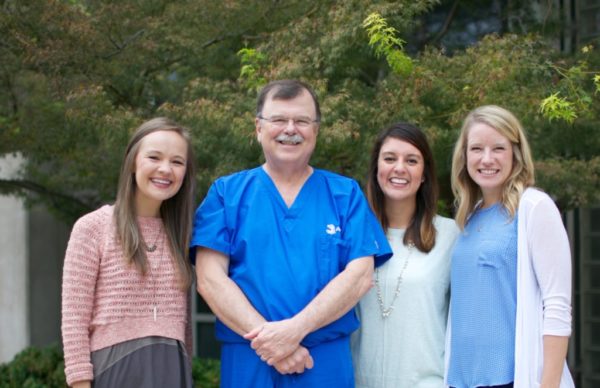While OB/GYNs are still the go-to professionals for infant deliveries in the United States, midwife-attended births are growing in popularity. And the majority of those births now occur in hospitals.
I must admit, the first time I heard the word “midwife” I thought of somebody in a peasant blouse and blue jeans, wearing a floral crown, boiling dandelion greens, and singing “Aquarius.”
But that’s not the reality. For centuries, midwives have been attending births in cultures all over the world. Today, there is a growing number of midwives who are registered nurses with master’s degrees. They work side-by-side with doctors to provide personalized care and counseling throughout pregnancy, labor, delivery and the postpartum period.
Written by Ann Metz on behalf of Tennova Healthcare
To set me straight on what midwifery is (or isn’t), I contacted Leonard A. Brabson, M.D., an obstetrician and gynecologist with Tennova Healthcare.
Dr. Brabson has delivered more than 15,000 babies in his 40-year career. His medical practice—Women’s Health Specialists and St. Mary’s Birth and Midwifery Center—includes three certified nurse midwives: Sarah Key, CNM, Blair Hicks, CMN, and Manola McCain, CNM.

KNOXVILLE MOM: What training do nurse midwives need?
BRABSON: In the U.S., there are two categories of midwives: nurse midwives, who are trained in both nursing and midwifery; and lay midwives, who are not necessarily nurses before they train to become midwives.
A certified nurse midwife (CNM) is a registered nurse who has graduated from an accredited midwifery education program and has passed a national certification examination. The majority of CNMs earn bachelor’s degrees in nursing, work as registered nurses—often in labor and delivery units at hospitals—and then choose to go back to school for a two- or three-year master’s degree program in midwifery. Currently, we have three CNMs at Tennova. And I anticipate the number will grow to meet the wants and needs of women in this community.
Lay midwives, also known as certified professional midwives (CPM), are able to assist with out-of-hospital births. They do not receive the same education or professional training as CNMs. In Tennessee, most CPMs work in home settings or freestanding birth centers.
KNOXVILLE MOM: So, to use a midwife, do I have to give birth at home?
BRABSON: Midwives practice wherever women give birth. According to the most recent numbers from the American College of Nurse-Midwives, the majority of midwife-attended births occur in hospitals (94.2 percent), while the remaining take place in homes or freestanding birth centers. In the Knoxville area, Physicians Regional Medical Center is the only hospital where women can experience a midwife-attended birth.
Furthermore, Medicaid reimbursement for CNM care is mandatory in all 50 states. Most states, including Tennessee, now mandate private insurance reimbursement for midwifery services.
KNOXVILLE MOM: How popular are CNM-attended births?
BRABSON: More and more women are choosing to give birth with the support of a nurse midwife. In fact, since 1989—the first year that CNM statistics were collected—the percentage of CNM-attended births has risen annually. In 2013, for example, midwives attended approximately 8 percent of all hospital births.
KNOXVILLE MOM: What’s the role of a nurse midwife?
BRABSON: The term “midwife” literally translates to “with woman.” Essentially, CNMs are trained to monitor the physical, psychological and social well-being of the mother throughout the pregnancy, labor and delivery. They provide individual prenatal care, education and counseling. And they give continuous hand-on support during labor. They also assist with postpartum mother and baby care as well as lactation assistance, if needed.
CNMs may minimize the use of technological and drug-related interventions as well. Although many patients will ask for and get epidurals, other methods to manage pain will likely be encouraged first, such as water labor, massage or acupressure techniques.
KNOXVILLE MOM: What happens if something goes wrong during my pregnancy or delivery?
BRABSON: At Physicians Regional Medical Center, women can work with both midwives and doctors to ensure that the delivery is both safe and comfortable, depending on the mother’s medical history and pregnancy course. For those who elect midwifery care, a risk assessment is done at the first prenatal visit and this process is on-going as the pregnancy progresses. If complications arise during pregnancy or childbirth, the CNMs will consult with me or another physician colleague.
Of course, not all pregnancies go as smoothly as planned. Sometimes, a C-section delivery may be indicated for the mom or baby’s health. In these cases, the midwife will accompany the woman to the operating room and remain with her for support. A CNM will resume care post-operatively to facilitate bonding and early initiation of breastfeeding.
KNOXVILLE MOM: Do midwives do anything besides “catch babies”?
BRABSON: Absolutely! In addition to attending births, nurse midwives have the skills to provide a wide range of women’s services, such as annual exams, nutrition counseling, parenting education and reproductive health visits. Although the focus is typically on pregnancy and childbirth, CNMs are medically trained to care for women from the time they begin menstruating though menopause and beyond.



















